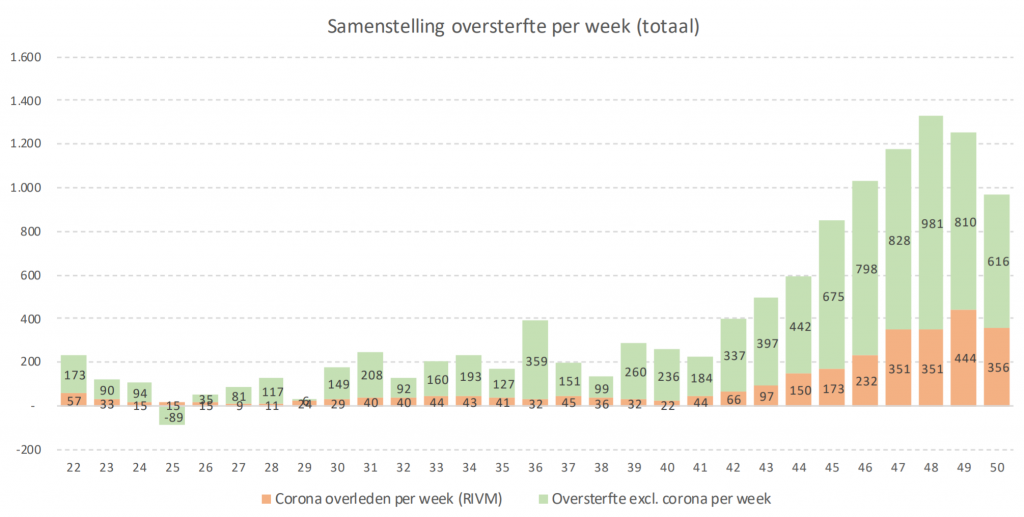Voor het eerst sinds ruim een half jaar is in week 49 en 50 de oversterfte twee weken achter elkaar gedaald. In het voorjaar begonnen de sterftecijfers op te lopen en in de zomer groeiden die door tot in december. Plausibele verklaringen zijn er niet voor gegeven en qua doodsoorzaken, die aan kunnen geven in welke richting er gedacht moet worden, houden CBS, rivm, OMT en de demissionair minister angstvallig de kaarten tegen de borst. De beoogde minister is momenteel OMT member OMT-vertegenwoordiger dus die eendracht is daarmee voor de toekomst gegarandeerd.

Toch vaccinatiedoden
We tellen nu bijna 9.000 oversterftedoden zonder dat we de coviddoden daarin meetellen. Dit wordt weergegeven in de grafiek met de cumulatieve weergave. Een aantal dat de tienduizend in ieder geval zal gaan halen in de twee weken die 2021 nog heeft te gaan. Dat is veel meer dan er in dezelfde periode aan Covid zijn overleden. Wat erger is, is dat het er volgens sommige rekenmethodes zelfs meer kunnen zijn [uit te werken in later artikel] dan er in 2020 daadwerkelijk aan Covid zijn overleden . Toen waren er nog geen vaccinaties, slechts SARS-CoV-2.
Omdat de overheid het alleenrecht eist op publieke cijfers, moeten we creatief worden in het vinden van duiding. Wie gewoon doorloopt en doet alsof er niets te zien is, verzaakt zijn of haar burgerplicht. We moeten op elkaar letten, zoals ook in veel Kerstboodschappen te lezen valt.
Veel mogelijke en plausibel klinkende oorzaken zijn de revue gepasseerd. Zij zijn gewogen door het Eucalyptisch Genootschap (een soort Red Team maar dan wat scherper) en te licht bevonden voor meer dan een beperkte bijdrage aan de sterfte. Alles overziend moet er een andere oorzaak dominant zijn en de enige overgebleven kandidaat is tot dusver de vaccinatiecampagne.
Alternatieve oorzaken onderuit door timing
Een toets die de meeste verklaringen niet kunnen doorstaan is de timing-toets: “Waarom begon het pas in april/mei?” Daarbij in het achterhoofd houdend dat een ondersterfte-effect de cijfers mogelijk drukt. Na de voorgaande golven mag immers ondersterfte worden verwacht, waardoor een gestaag toenemende oversterfte pas later in de cijfers tot uitdrukking is gekomen.
De Volkskrant kletste dat het toch coronadoden waren. Het rivm zou haar registratiewerk beroerd uitvoeren door slechts een kwart van de coronasterfte in de gaten te hebben. Terwijl ze toch al bijna twee jaar hun verslaggeving daarop baseren. Maar dan rijst de timingvraag: waarom ineens vanaf april, en dan in toenemende mate steeds slechter?
Algemene sociaal-economische disruptie? Dat noemde ik eerder al en ook Maurice de Hond opperde “Algehele ontregeling” zelfs als belangrijkste oorzaak. Zoals het EG terecht opmerkt is dat lastig te kwantificeren. Ook is onduidelijk onder welke leeftijdsgroepen zich dat dan zou moeten afspelen en welke doodsoorzaken daarmee gemoeid zouden zijn. Maar opnieuw sputtert vooral de timing tegen: de ontregeling begon in maart vorig jaar immers al. Duurt dat een jaar en gaat het dan als een raket omhoog? Hoe is dat dan weer te verklaren? Je zou veel geleidelijker trends verwachten.
Dit geldt ook voor “uitgestelde zorg”. Waarom nu plotseling die effecten? Dit nog los van het feit dat de behandelgegevens van ziekenhuizen geen aanleiding geven om een jaar later sterfte in deze orde van grootte te kunnen bewerkstelligen; weinig uitgestelde zorg ging om levensbedreigende situaties. Ook hier is een plotselinge opleving onwaarschijnlijk; die effecten zouden langer door moeten werken. Ik verwijs opnieuw naar het EG-stuk.
Weer nieuwe aanwijzing voor vaccinatiedoden
Vrijwel alle alternatieve verklaringen betreffen langetermijn-problematiek, die vele jaren of misschien zelfs decennia aan zou kunnen houden. Daar past het beeld van het afgelopen jaar niet bij. In een half jaar van 0 naar 8.000 doden, dat is geen langetermijn trend (hopelijk).
Dit criterium wordt nu sterk aangescherpt doordat het ernaar uitziet dat de cijfers nu alweer stevig dalen. Zet die dalende trend door dan kunnen alle systemische verklaringen (sociaal, maatschappelijk, psychologisch, administratief, lifestyle etc) gevoeglijk terzijde geschoven worden. Van deze scenario’s is het moeilijk voorstelbaar dat ze een sterftepiek veroorzaken terwijl de disruptie en sociale ellende door de overheid nog steeds wordt verergerd en de bevolking verder tegen elkaar wordt opgezet. Met de beste bedoelingen uiteraard, begrijp mij niet verkeerd.
Dat vraagt dan nog nadrukkelijker om de verklaring van een kortstondige sterftepiek in plaats van een langdurigere verhoging van de oversterfte – die nog steeds niet uitgesloten is maar niet in deze aantallen of met deze exorbitante fluctuatie.
Dit neemt niet weg dat de overige verklaringen wel degelijk een lichte maar structurele verhoging van de sterfte kunnen laten zien, de komende jaren of decennia.
Nu aangedragen verklaringen door de afnemende piek nog minder houdbaar blijken dan ze al waren, blijft er nog steeds 1 aannemelijke verklaring overeind. Totdat er fatsoenlijke data beschikbaar worden gemaakt die anders uitwijzen, heb ik er geen moeite mee om over (vermoedelijke) vaccindoden te spreken. Hopelijk noopt dit deze en gene tot het transparant maken van de sterftecijfers, leeftijdsgestratificeerd, met doodsoorzaken en vaccinatiedatums.
Het booster-effect
De komende maanden heeft het CBS, als het aan de Jonge ligt, de handen vrij om verder te werken aan het plausibiliseren van de doodsoorzaken. Intussen is de boostercampagne alweer in volle gang. Dat de Covidsterfte sterk zal zakken dankzij de Omikronvariant staat buiten kijf, net zoals we de huidige dalende ziekenhuisopnames daaraan te danken hebben. Het wordt een uitdaging om onder die wisselende omstandigheden zinnige vergelijkingen te blijven maken. Zullen we over een aantal weken weer een bult in de “onverklaarde oversterfte” zien op basis van CBS- en rivm-cijfers? We zullen het gaan meemaken.



